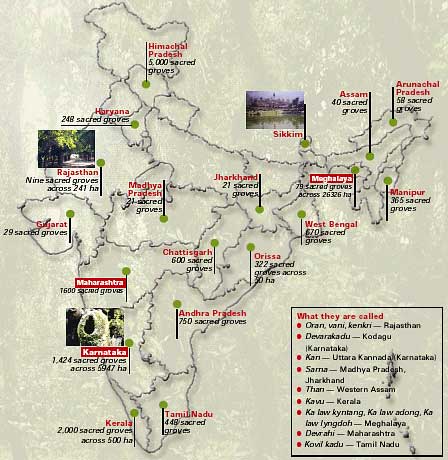|
The dictionary can provide hints. More
clues can be had from travelling to the sacred groves themselves.
According to Webster’s New World
dictionary:
adj.
1 consecrated to or belonging to the
divinity or a deity; holy
2 regarded with the respect or reverence accorded holy things; venerated; hallowed
3 set apart for, and dedicated to, some person, place, purpose, sentiment, etc.
"sacred to his memory"
4 secured as by a religious feeling or sense of justice against any defamation, violation,
or intrusion; inviolate adj.
1 characterised by adherence to religion
or a religion; devout; pious; godly
2 of, concerned with, appropriate to, or teaching religion "religious books"
3 belonging to a community of monks, nuns, etc.
4 conscientiously exact; careful; scrupulous
This is another word worth adding to our
vocabulary:
n., a small, isolated area that has escaped the extreme changes undergone by the
surrounding area, as during a period of glaciation, allowing the survival of plants and
animals from an earlier period.
|
Each region has its own name for it — kavus, ka law kyntang, devarakadus,
orans, sarnas. Each region has its own needs for it. Some scientists club
them together as refugia. Others call them relic-forests. By design or by default, they
are  remnant patches of native vegetation surviving in
their natural form. But what is the natural form of vegetation in India? How long back in
time does one have to go to find the definitive true forest? remnant patches of native vegetation surviving in
their natural form. But what is the natural form of vegetation in India? How long back in
time does one have to go to find the definitive true forest?Before finding answers to such questions, it could be worthwhile
to spot India’s sacred groves on a map. But that would raise even more questions.
What are the common principles that hold a patch of khejadi trees in Rajasthan safe and
also ensure that a village in Mizoram maintains a patch of a sub-evergreen vegetation as a
safety forest. Are there any shared principles that hold a lonely sacred grove in
Cherrapunjee, Meghalaya and a small privately protected kavu, home to a small
reservoir of medicinal plants, in the Western Ghats of Kerala, together? Perhaps there
are.
|
|
|
Himachal Pradesh: One
alpine wonder
The Chhakinal watershed in Kullu: nine hamlets; 322 families; 21.5 per cent land
demarcated as sacred; each hamlet with its own sacred grove; one common and well-protected
area called Nagoni sacred forest. Above the tree line: a 5 ha alpine meadow kept sacred,
though not protected. Nagoni holds a large number of species over a small area. The
smaller groves closer to the hamlets cannot sustain many species. Sowing, harvesting and
migration is undertaken only after a sacrifice is made at the sacred grounds.
Rajasthan: Of rural
designs
The Bishnois in Shekhala village, 95 km northwest of Jodhpur city, define land-usage to
meet their frugal needs. The sacred grove is central to this system:
| Land use |
Common grazing land |
Sacred area |
Private grazing land |
Agricultural land |
Afforested area |
| Fuel wood |
40 |
10 |
46 |
2 |
2 |
Timber/
Small wood |
20 |
0 |
80 |
0 |
0 |
| Fodder/grazing |
30 |
20 |
38 |
10 |
2 |
Medicinal/
other extracts |
5 |
40 |
40 |
15 |
0 |
| Water |
0 |
15 |
0 |
0 |
0 |
| Note: all figures are in percentage of
total demand |
Madhya Pradesh: Baiga
property
At one time, only members of the Baiga tribe were allowed to collect deadwood from the sarnas
— the sacred groves. Exploitation of these groves for individual benefit was
prohibited. In some sarnas today, trees are leased to villagers for collection of sal
seeds. Researchers say the sarnas have, of late, been opened up for extraction of
non-timber forest produce as the other forests nearby have been denuded and diminished.
Sikkim: Logic at great
heights
The highlands of Demojong below the Khangchendzonga peak are the most sacred site for the
Sikkimese Buddhist. The region has a number of glacial lakes that feed, besides others,
the sacred river Rathong Chu. Any human activity here, it is believed, spells disaster for
the region.
Assam: Ancient tradition
The forest dwelling tribes of the Bodo and Rabha in the plains and foothills of western
Assam have an ancient tradition of groves which are locally known as than. Karbi
Anglong district has about 40 sacred groves. The Dimasa tribe of Haflong district maintain
groves, called madaico, measuring about one acre each. Vaishnavite monasteries have
also preserved numerous sacred groves.
Manipur: A secular idea
The Gangte tribe in Churachandpur district of Manipur earlier believed spirits and deities
reside in sacred groves. where lopping was disallowed. With the advent of Christanity they
cut down many of these groves but soon realised how imperative the groves are to their
agriculture. They regenerated the degraded patches, now calling them, to go along with
their new faith, just ‘safety forests’. Their agriculture is now restored to
health. |
